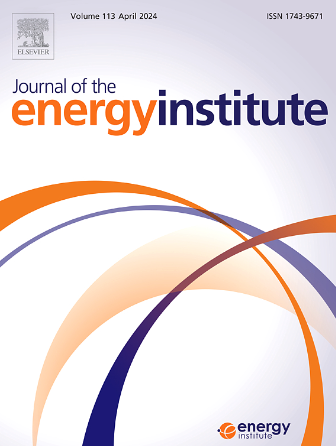Study on the effect of ammonia mixing ratio on process of ammonia and coal co-combustion
IF 5.6
2区 工程技术
Q2 ENERGY & FUELS
引用次数: 0
Abstract
Ammonia-coal co-combustion has emerged as a promising strategy for reducing carbon dioxide emissions. However, the quantitative impact of ammonia mixing ratios on the ignition and volatile combustion stages remains unclear, particularly under varying temperatures. In this study, a high-resolution optical measurement system coupled with Python-based image processing algorithms was developed to analyze the ignition distance, flame brightness, and morphology of pulverized coal particles.
Key findings include
At 1500 K, the ignition distance of pulverized coal increased from 9.0 mm to 16.5 mm as the ammonia mixing ratio rose from 0 % to 40 %, attributed to competing timescales between coal heating and ammonia product diffusion; At 1800 K and 1200 K, ammonia mixing exhibited negligible effects on ignition distance (6.5–6.7 mm and 5.5–4.7 mm, respectively), highlighting temperature-dependent dominance in combustion kinetics; Volatile ignition distance showed a negative correlation with ammonia mixing at extreme temperatures but a positive correlation at 1500 K, linked to oxygen competition and active species generation.
These results provide critical insights for optimizing ammonia-coal co-combustion systems in industrial applications.

氨混比对氨煤共燃过程影响的研究
氨煤共燃已成为减少二氧化碳排放的一种很有前途的策略。然而,氨混合比例对着火和挥发性燃烧阶段的定量影响仍不清楚,特别是在不同温度下。在本研究中,开发了一种高分辨率光学测量系统,结合基于python的图像处理算法来分析煤粉颗粒的点火距离、火焰亮度和形貌。主要发现包括:在1500 K时,随着氨混合比从0%增加到40%,煤粉的着火距离从9.0 mm增加到16.5 mm,这是由于煤加热和氨产物扩散的时间尺度竞争;在1800 K和1200 K时,氨混合对燃烧距离(分别为6.5-6.7 mm和5.5-4.7 mm)的影响可以忽略不计,这表明燃烧动力学中温度依赖的优势;在极端温度下,挥发性点火距离与氨混合呈负相关,而在1500 K时,挥发性点火距离与氧竞争和活性物种产生呈正相关。这些结果为优化工业应用中的氨煤共燃系统提供了重要的见解。
本文章由计算机程序翻译,如有差异,请以英文原文为准。
求助全文
约1分钟内获得全文
求助全文
来源期刊

Journal of The Energy Institute
工程技术-能源与燃料
CiteScore
10.60
自引率
5.30%
发文量
166
审稿时长
16 days
期刊介绍:
The Journal of the Energy Institute provides peer reviewed coverage of original high quality research on energy, engineering and technology.The coverage is broad and the main areas of interest include:
Combustion engineering and associated technologies; process heating; power generation; engines and propulsion; emissions and environmental pollution control; clean coal technologies; carbon abatement technologies
Emissions and environmental pollution control; safety and hazards;
Clean coal technologies; carbon abatement technologies, including carbon capture and storage, CCS;
Petroleum engineering and fuel quality, including storage and transport
Alternative energy sources; biomass utilisation and biomass conversion technologies; energy from waste, incineration and recycling
Energy conversion, energy recovery and energy efficiency; space heating, fuel cells, heat pumps and cooling systems
Energy storage
The journal''s coverage reflects changes in energy technology that result from the transition to more efficient energy production and end use together with reduced carbon emission.
 求助内容:
求助内容: 应助结果提醒方式:
应助结果提醒方式:


